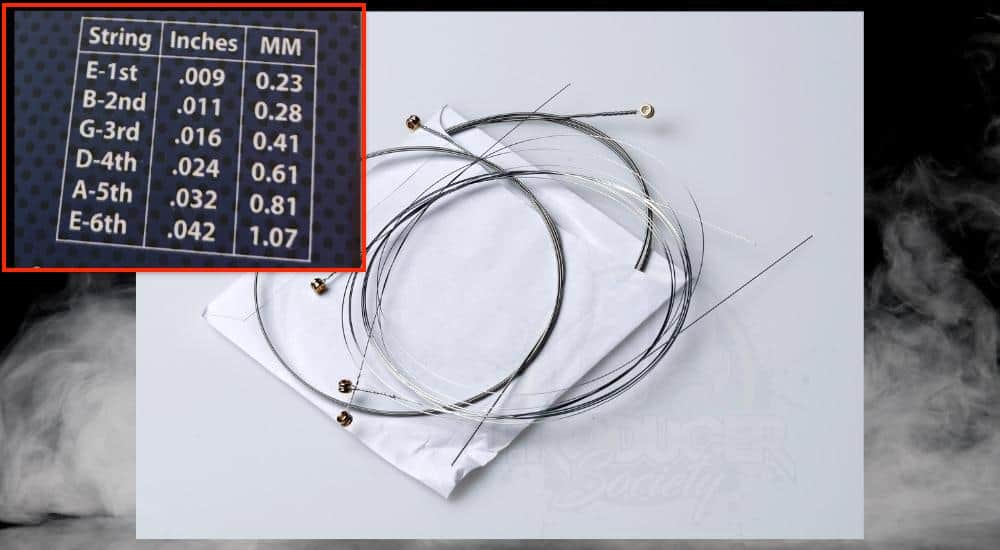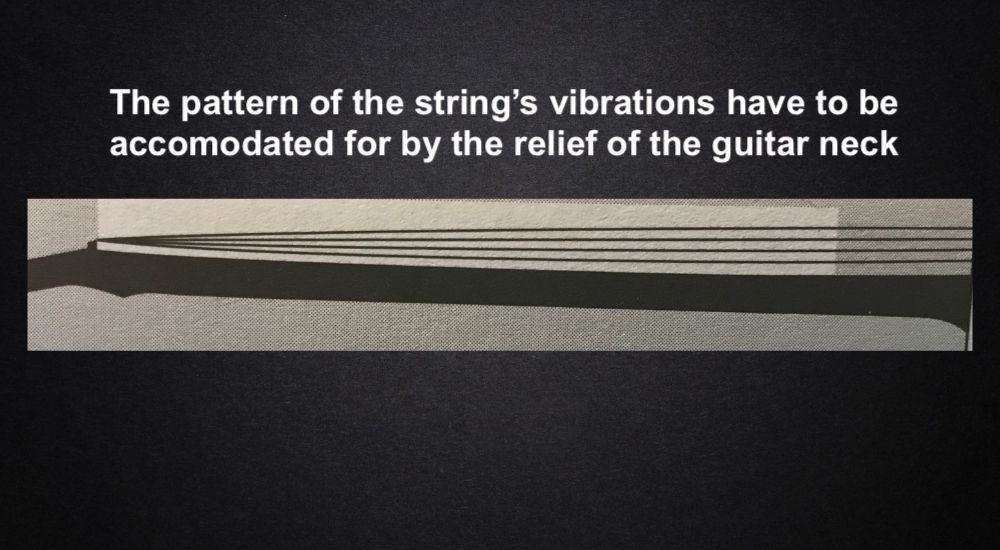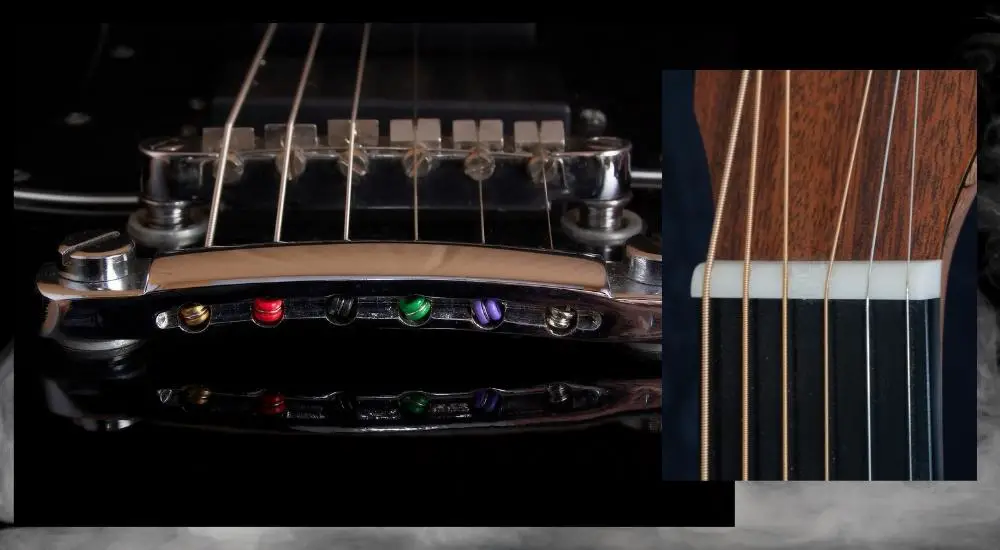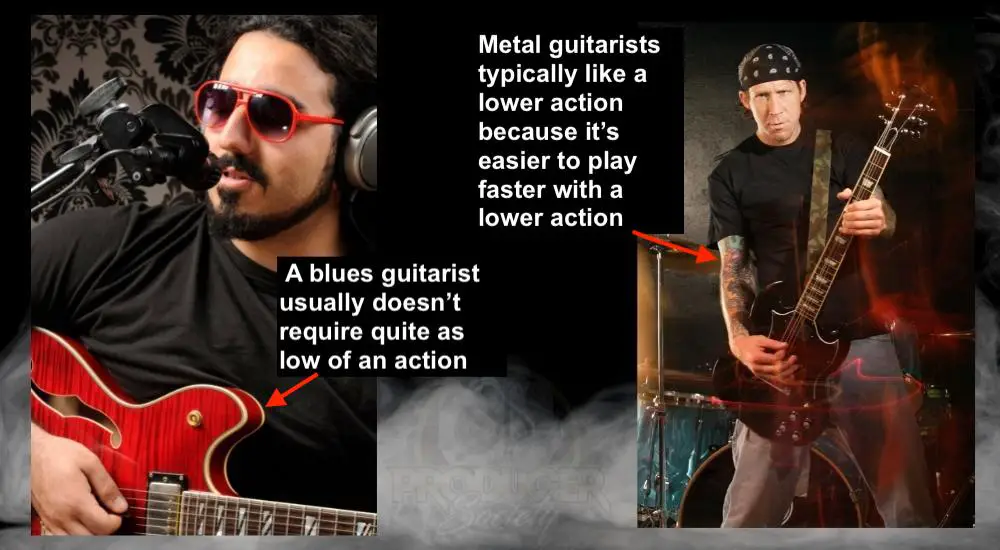How easy it is to play the guitar depends on a number of factors, including how much relief there is, the action, in addition to the string thickness. An improperly set up action can make any great guitar sound bad through things like fret buzz or the extreme version of this: fretting out.
On the other hand, if your action is too high, you’ll have intonation issues and the guitar will sound weirdly out of tune in some spots and perfect in others. While it’s not that complicated to get right, setting up a guitar does have some nuances. One is the string height which a lot of people ask about, particularly whether they should all be the same height.
Generally speaking, guitar string height is not equal across all strings because thicker ones need room to vibrate. However, it often comes down to personal preference. Note that the bridge doesn’t give equal clearance to all strings, making the action higher near the bridge than the nut.”
As I’ve alluded to already, height is determined by things like string thickness, vibrational pattern, neck straightness, and how heavy the strings are.
Depending on what kind of guitar you have, you’ll have a specific height for your bridge, nut, and fret clearance. But it ultimately comes down to the action the player wants and also how good the fretwork is.
Why Guitar Strings Shouldn’t Be The Same Height
1) Each String is Not The Same Thickness

Lower-pitch strings need to be thicker and higher-pitched strings don’t need as much thickness. That’s just how the physics of vibration works, and for that reason, the guitar’s action will need to be set up in a particular way to accommodate that simple fact.
It’s not uncommon for guitar actions to be set up so that it’s 4/64 on the low-E side and then 3/64 on the high-E side. For many, this is considered a medium action and it’s fairly easy for a lot of people to play this way.
Like I said earlier though, you’ll need a guitar with good fretwork if you want to go a lot lower without fret buzz. Let’s take a look at the way guitar strings vibrate because it’s helpful to understand guitar action.
2) Guitar Strings Vibrate In An Elliptical pattern

Strings vibrate in an elliptical fashion so the height from the nut and saddles would have to be high enough to accommodate the largest diameter of the ellipse, at the center of the length of the string from end to end.
There needs to be a tiny bit of relief in the neck to accommodate the way the strings vibrate which is illustrated fairly well in the image above.
One of the reasons why people often say that thicker strings permit a lower action is because it reduces the size of the elliptical pattern when the strings are in the middle of vibrations.
The reason for this is that they’re much tighter. This is the same reason why guitarists who need a dropped tuning have thicker strings. The same thing goes for the bass guitar as well.
3) The Bridge and Nut Are Slightly Different Heights

As much as we try to get the action even from the bridge to the nut, the action at the 24th or 22nd fret will usually be slightly higher than the 1st fret.
Any big-name guitar companies have specs for string height at the 1st and 12th frets that will clearly show you the order for a guitar to play well and intonate properly. PRS has theirs here, for instance.
That said, all guitars are different, and some manufacturers are much better at setting up their instruments than others. I’ve said before that Suhrs are known for having amazing fretwork. The way the nut and bridges are made is just another important factor.
4) The Player May Request It Due To Preferences Or Difference In Genre

If the player requests lower action on the higher strings and higher on the lower strings, or the strings are heavier top, lighter bottoms, then that may require a special way to set up a guitarist’s action.
For the most part, guitarists like low action, and they’ll commonly say to technicians that they want the lowest action they can get without fret buzz.
This also has to do with the genre as well. As the image above suggests, certain genres of music necessitate a particular kind of setup.
Metal guitarists, for instance, need a much lower action usually because they tend to play much faster and they also use high-gain rigs and distortion.
A jazz guitarist can get away with a higher action because they’re usually not similarly shredding the guitar, moreover, they commonly use a clean tone, so they can’t afford to have annoying fret buzz sounds in the same way that a metal guitarist would. Distortion, gain, and effects cover up these imperfections.
How High Should The Guitar Strings Be?
Electric guitars will almost always have lower action than acoustic guitars, but most big-name brands have close to the same specs for string height in a proper setup.
A good default string height is typically 4/64th of an inch (2.38mm) on the bass side and 3/64th of an inch (1.59mm) on the treble side for the electric guitar.
For the acoustic, it’ll be closer to 7/64th of an inch (2.78mm) on the bass side and 5/64th of an inch (1.98mm) for the rebel, but as I said, it depends on the genre, the quality of fretwork of the genre, and how well the guitar is built in general.
A good rule of thumb is the chart that I’ve made down here. You usually won’t go wrong with a 4/64″ string height measured at the bottom of the string and the top of the fret at the 17th fret. I prefer having my relief set to between 0.005″ and 0.010″ as well which is fairly straight, especially toward 0.005.”
| Setup Parameter | Measurement | Factory Specification |
| Truss Rod Relief | 0.005″ (0.127mm) | 0.005″ – 0.010″ |
| String Height | 4/64″ (1.58mm) *Measured at the 17th fret from the bottom of each string. | 2/32″ at 12th fret (Treble Side) 2.5/32″ – 12th fret (Bass Side) |
| Pickup Height | 3/32″ for Neck Pickup and 1/16″ for Bridge Pickup – while holding down the very last fret on the guitar neck. *Measured at Both High and Low E-String Side of the Pickup | 3/32″ Bass Side (Both Pickups) 5/64″ Treble Side (Both Pickups) |
Paul Reed Smith guitars recommend the string action be set at 5/64 on the bass side and 4/64 on the treble side measured at the 12th fret.
Fender recommends the action of the strings to be, depending on neck size, between 5/64 (Bass) and 4/64 (treble) for smaller necks and 4/64 (bass) and 3/64 (treble) for larger necks. Check your guitar maker’s website for standard specs because they’re not all the same.
Should String Action Be Even?
The action depends on the player. If the player is heavy-handed, then they need higher action. If the player is a lighter-handed player or a shredder, they need lower action to hit the notes properly.
Usually, string action is set up in such a way so as to accommodate the thicker low-end strings (E, A, and D) so it’s lower at the nut and slightly higher near the bridge.
Other Articles You May Be Interested In
- How Tight Should Guitar Strings Be? [ANSWERED]
- What Makes Guitar Strings Go Dead? [ANSWERED]
- Why Do Jazz Guitarists Use Heavy Strings? [ANSWERED]
- Should Guitar Strings Be Parallel to the Fretboard? [NO]
Important Things to Note About Guitar String Height
1) You Can Adjust The Action Yourself
You can adjust the action on any electric guitar pretty easily by yourself (especially with my guide to help you). Acoustic guitars are a little more temperamental, so they require more detailed work.
The article I’ve linked above has plenty of tools that you’ll need to do so, however, the first one that comes to mind is the Mituyoto ruler. It isn’t hard at all, don’t worry.


 Written By :
Written By :
